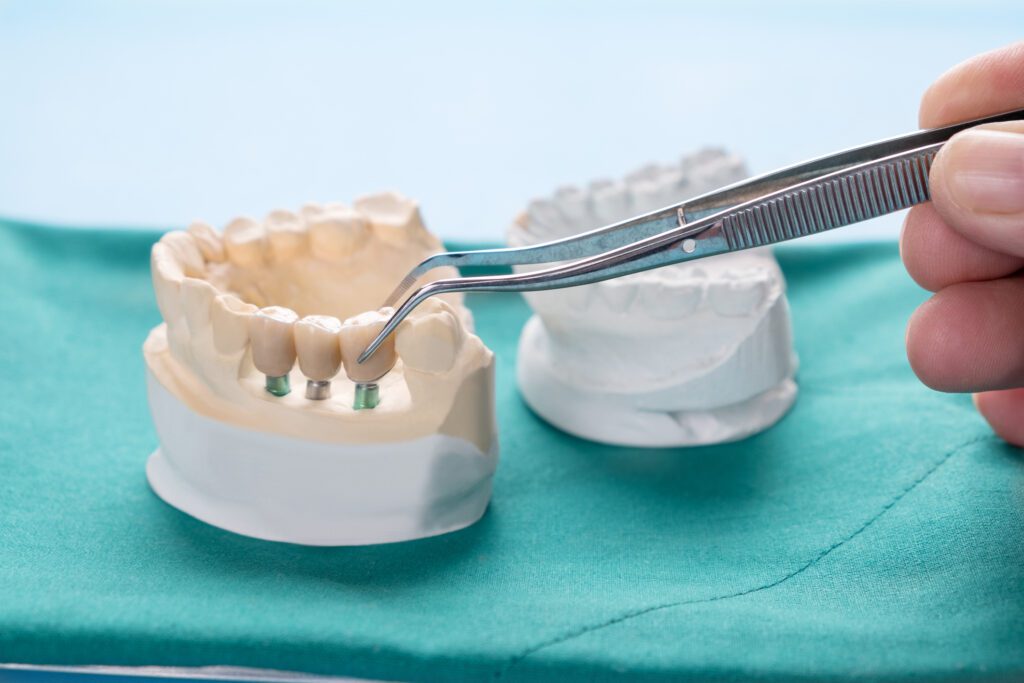One or more missing teeth in a row, especially in the front of the mouth, negatively affects your confidence. You may cover your teeth around others because of tooth gaps. Multiple missing teeth can also make eating the foods you love difficult. Receiving a dental bridge in Nederland, TX, fills gaps in the mouth for a fuller and more stable bite. Bridges are dental restorations that restore a row of missing teeth to improve bite function and aesthetics.

Types of Dental Bridges
Bridges are made of abutments and pontics. Abutments are the pieces that support the bridge. Pontics are the custom-made false teeth. A traditional bridge may use false teeth secured by natural teeth. However, there are many different types of bridges to choose from:
- Traditional: A traditional bridge uses support from natural teeth on either side of a tooth gap. They may be removable or fixed. However, removable bridges may require more maintenance over time.
- Cantilever: This bridge uses one tooth on one side of a tooth gap for support. Because this bridge receives support from only one side, it may not be as stable as other options.
- Maryland: A Maryland bridge is a false tooth with metal wings. The wings bond to natural teeth on either side of the tooth gap. Patients with single missing teeth may benefit from this bridge if they don’t want an implant.
- Implant: Implant-supported bridges do not use natural teeth for support. Instead, it uses small titanium screws that anchor into the jaw bone. Dental implants help bridges last longer without needing to prepare natural teeth.
Our office provides traditional fixed bridges or implant-supported bridges. Compared to other bridges, these bridges last longer. Because they are fixed in place, you don’t have to worry about potentially damaging or losing your restoration. Fixed bridges are also simpler to clean.
Benefits of Dental Bridges
After you receive a dental bridge in our office, you will notice a change in your oral health. Dental bridges:
- Improve speech and pronunciation
- Prevent shifting teeth
- Allow you to eat more foods with better nutrition
- Increase bite function
- Improve the look of your smile
Replacing missing teeth with a custom-made bridge can help you regain your smile. Bridges prevent the many problems you can experience after you lose one or more permanent teeth. These problems include shifting teeth, an increased risk of decay, and difficulty eating. We recommend replacing missing teeth as soon as possible to keep your teeth, gums, and jaw healthy.
However, traditional and removable bridges lay on the gums and do not support the underlying bone. Jaw bone support is essential to improving your bite. Supporting the jaw bone with a restoration can also help prevent facial sagging. For this reason, we may recommend dental implants to secure a bridge if you are a candidate.
Dental Bridge Treatment in Nederland, TX
Before bridge treatment, we will take dental X-rays to see if a bridge is the right restoration for you. We will also consider your specific goals and budget. Our office can treat gum disease or tooth decay to ensure you are healthy before treatment.
If you receive a traditional dental bridge, we will prepare the teeth on either side of your missing tooth gap. Then, we take impressions to create a custom bridge. During this time, we will provide a temporary restoration. Once your bridge is complete, you will return to our office. We remove the temporary and secure the final bridge in place.
We will work with a local oral surgeon if you choose an implant-supported bridge. First, the surgeon places the implants in the jaw bone. Over several months, the implant will fuse with the jaw bone. We will take impressions to create your final bridge. Then, once your implants heal, you will return so we can secure your dental bridge.
Dental Bridge FAQs
Learn more about tooth bridges with answers to these commonly asked questions:
How many teeth can bridges replace?
Bridges can replace one to two or one to four teeth. If you have only a single lost tooth, we may recommend a dental implant covered by a dental crown. Partial dentures may benefit you if you have more teeth missing.
Are bridges and partial dentures the same?
No, bridges and partials are not the same. A partial denture can replace consecutive missing teeth in different parts of the mouth. Dental bridges only replace a single row of lost teeth. Both restorations can use implants for support.
How are dental bridges attached?
Depending on your bridge type, your restoration can attach to implants, crown-capped teeth, or the back of natural teeth. Implant-supported bridges use metal implants. Traditional removable or fixed bridges use teeth covered by dental crowns. Maryland bridges use metal wings bonded to the back of teeth.
How long can it take to get a dental bridge?
A traditional bridge can take several weeks. Implants take longer. It can take months for your implants to heal after placement. Preparing for a bridge can add time to your treatment. Removing teeth, treating gum disease, and filling cavities will lengthen treatment.
How long do dental bridges last?
A traditional bridge can last five to fifteen years. Implant bridges last longer, typically ten or more years. The implant post is permanent and will stay as long as you care for your teeth and gums.
How do you clean dental bridges?
If you have a removable bridge, brush your bridge with a denture cleaner and soft-bristled brush. Use cool or lukewarm water. It’s essential to clean beneath your bridge. Use an interdental brush or floss around your bridge to clean food debris and bacterial buildup.
You can brush your restoration like natural teeth with a fixed or implant bridge. Use a soft-bristled toothbrush and non-abrasive toothpaste.
Fix Missing Tooth Gaps
Get a dental bridge in Nederland, TX. Call 409-215-2035 or schedule your next dental appointment online. If you are unsure if a bridge is right for you, contact us for a consultation. We will examine your smile to find the best restoration for you.
